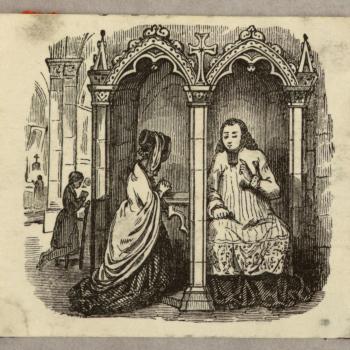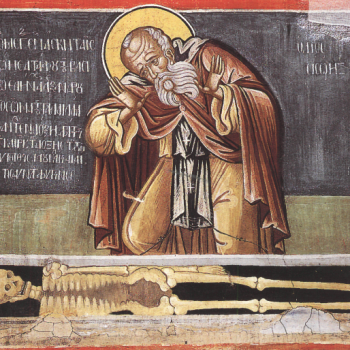
The Sikh faith has its beginnings in the late 15th-early 16th centuries, with a man known as Guru Nānak Dev ji—the first of the ten Sikh mortal Gurus. Nānak is often referred to as “father Nānak” (or Bābā Nānak), owing to the fact that he founded the faith.
As a child, Nānak—a Pakistani-born Hindu—was different from other children, in that he had little interest in playing or doing child-like things. All he really wanted to do was think about and discuss spiritual things. As he grew, he spent long periods of time singing hymns, or sitting by the river praying. On one such trip to the river, Nānak entered the water and did not emerge for three days. (While this is the traditional narrative, some Sikhs today say that he passed through the river, emerged on the other side, and wandered in the woods on the other side of the river for those three days.) During that three-day period, Nānak was escorted to the presence of God. While there, he was given the command to rejoice in God’s name, and to teach others to do the same. Upon emerging from the river, he declared: “There is neither Hindu nor Muslim, so whose path shall I follow? I shall follow God’s path. God is neither Hindu nor Muslim, and the path I follow is God’s.” In other words, Nānak had discovered (during his time in God’s presence) that everyone really worships the same God—even though they call the divine by different names or have different beliefs about God.
Like nearly every other religion, Sikhism has its own scriptural canon. Daily readings from the scriptures are considered the duty of each Sikh. The Sikh scriptures consist of hymns written by Guru Nānak and five of his successors, in addition to writings from some Muslim ascetics (or fakirs) and a few Hindu saints, bhaktas or holy men. In their canon, there are approximately 6,000 hymns written by the Gurus (or leaders) of Sikhism. The text is unique as scripture, not only because it is made up primarily of hymns (rather than narrative or doctrinal expositions), but also because the authors of the canonized words come from a variety of religious traditions, including Hinduism, Islam, and Sikhism. The Patheos library points out: “Over a dozen non-Sikh poet saints were selected to be included in the Sikh text. These poet-saints come from a variety of caste and religious backgrounds, and their inclusion provides a sense of honor for Sikhs who consider their holy book the world's only ‘interfaith scripture.’”
Their scriptures, which they refer to as the Guru Granth (or Adi Granth, meaning “the first book” or the “original book”), are treated like a human being. In Sikh temples, the scriptures are placed on an elevated throne-like cot (or “takht”—meaning “seat of power” or “throne of authority”). Over the scriptures is placed a decorated canopy. The Guru Granth traditionally rests on cushions or pillows. Each night the Granth is “put to bed”—and then, in the morning, it is brought out again. (Many Sikhs will actually set aside a room in their home to house a copy of the Granth.) Those who handle smaller versions of the text will ofttimes carry it above their heads and wear gloves when touching it; and, out of reverence, readers of the text will generally try to avoid directly breathing on the pages of the sacred book. Worshipers bow in front of the scriptures, and traditionally do not turn their backs on the book.
The reason for this very reverential treatment of their scriptures does not stem from a belief that the scriptures are literally “alive.” Rather, their respectful treatment of the canon is found in their belief that Guru Nānak had a “soul” or “imperishable light” that passed from him to each of his successors in the Sikh guruship, ultimately landing on the Guru Granth Sahib, the sacred scriptural book of Sikhism. Prior to his passing, Nānak explained the Sikh doctrine of joti jot, the belief that only his mortal body would expire at his death, but the “light” which illumined him was the divine and imperishable light, and it would pass from him to each of his successors.
On October 6th, 1708, the day before his assassination, Guru Gobind Singh—the tenth of the mortal gurus and lineal successor of Nānak—declared that, instead of having an eleventh human Guru (who would succeed him), after his death the “imperishable light” or “soul” of Nānak would enter the Guru Granth Sahib, or scriptures. Gobind Singh commanded practitioners, “Guru maneyo Granth,” meaning “consider the Granth to be the/your Guru.” In so doing, he was affirming that the scriptures were sacred, that the line of human gurus was now officially terminated, and that Nānak would remain present and among the people of Sikhism through the Granth. (Moving forward, whenever Sikhs would gather, and the Guru Granth was present, Nānak would also be present.) From that time forward, Sikhs would regard the scriptures as their Guru or “teacher.” Hence, the Sikh canon has become the embodiment of the soul of the Gurus and the very embodiment of God.
In all Sikh temples or gurdwaras, the Guru Granth is present and central to worship. One Sikh noted, “Sikh religious, ethical, and ceremonial life revolves around the text and presence of the Guru Granth Sahib.” It is treated as the presiding presence of the Guru in their temple and during their worship. Thus, the “house of worship” (as Westerners might call it) becomes a “gurdwara”—meaning a “house of the Guru.” There, in the “house of the Guru,” Sikhs gather to worship and receive divine direction for their lives: “Every day, wherever there is an enshrined copy of the Guru Granth Sahib, a reading is done from it at random. The hymn that is read (vaak) is considered to be the Guru's command (hukam) for the congregation for that day.”
5/14/2024 8:37:23 PM










